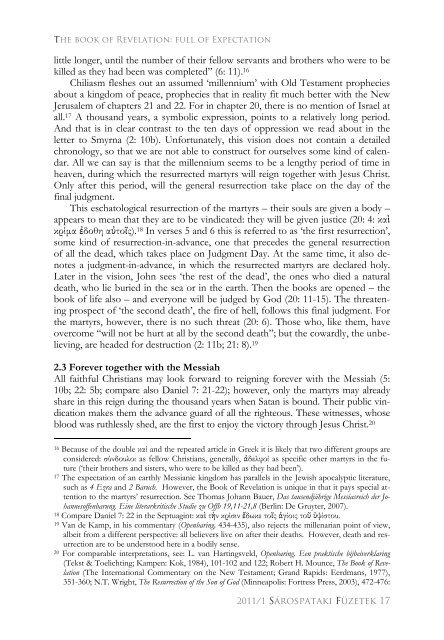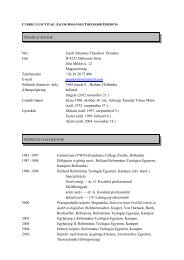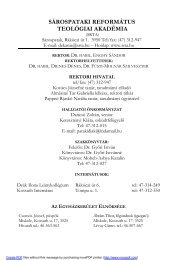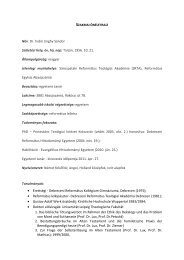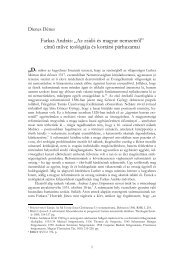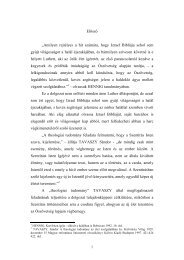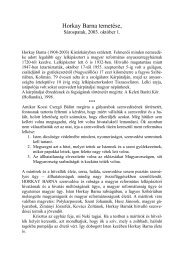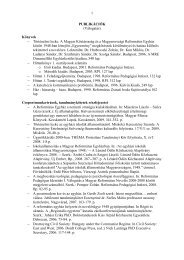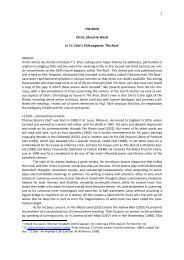2011/1 - Sárospataki Református Teológiai Akadémia
2011/1 - Sárospataki Református Teológiai Akadémia
2011/1 - Sárospataki Református Teológiai Akadémia
- No tags were found...
Create successful ePaper yourself
Turn your PDF publications into a flip-book with our unique Google optimized e-Paper software.
The book of Revelation: full of Expectation<br />
little longer, until the number of their fellow servants and brothers who were to be<br />
killed as they had been was completed” (6: 11). 16<br />
Chiliasm fleshes out an assumed ‘millennium’ with Old Testament prophecies<br />
about a kingdom of peace, prophecies that in reality fit much better with the New<br />
Jerusalem of chapters 21 and 22. For in chapter 20, there is no mention of Israel at<br />
all. 17 A thousand years, a symbolic expression, points to a relatively long period.<br />
And that is in clear contrast to the ten days of oppression we read about in the<br />
letter to Smyrna (2: 10b). Unfortunately, this vision does not contain a detailed<br />
chronology, so that we are not able to construct for ourselves some kind of calendar.<br />
All we can say is that the millennium seems to be a lengthy period of time in<br />
heaven, during which the resurrected martyrs will reign together with Jesus Christ.<br />
Only after this period, will the general resurrection take place on the day of the<br />
final judgment.<br />
This eschatological resurrection of the martyrs – their souls are given a body –<br />
appears to mean that they are to be vindicated: they will be given justice (20: 4: καὶ<br />
κρίμα ἐδοθη αὐτοῖς). 18 In verses 5 and 6 this is referred to as ‘the first resurrection’,<br />
some kind of resurrection-in-advance, one that precedes the general resurrection<br />
of all the dead, which takes place on Judgment Day. At the same time, it also denotes<br />
a judgment-in-advance, in which the resurrected martyrs are declared holy.<br />
Later in the vision, John sees ‘the rest of the dead’, the ones who died a natural<br />
death, who lie buried in the sea or in the earth. Then the books are opened – the<br />
book of life also – and everyone will be judged by God (20: 11-15). The threatening<br />
prospect of ‘the second death’, the fire of hell, follows this final judgment. For<br />
the martyrs, however, there is no such threat (20: 6). Those who, like them, have<br />
overcome “will not be hurt at all by the second death”; but the cowardly, the unbelieving,<br />
are headed for destruction (2: 11b; 21: 8). 19<br />
2.3 Forever together with the Messiah<br />
All faithful Christians may look forward to reigning forever with the Messiah (5:<br />
10b; 22: 5b; compare also Daniel 7: 21-22); however, only the martyrs may already<br />
share in this reign during the thousand years when Satan is bound. Their public vindication<br />
makes them the advance guard of all the righteous. These witnesses, whose<br />
blood was ruthlessly shed, are the first to enjoy the victory through Jesus Christ. 20<br />
16 Because of the double καί and the repeated article in Greek it is likely that two different groups are<br />
considered: σύνδουλοι as fellow Christians, generally, ἀδελφοί as specific other martyrs in the future<br />
(‘their brothers and sisters, who were to be killed as they had been’).<br />
17 The expectation of an earthly Messianic kingdom has parallels in the Jewish apocalyptic literature,<br />
such as 4 Ezra and 2 Baruch. However, the Book of Revelation is unique in that it pays special attention<br />
to the martyrs’ resurrection. See Thomas Johann Bauer, Das tausendjährige Messiasreich der Johannesoffenbarung.<br />
Eine literarkritische Studie zu Offb 19,11-21,8 (Berlin: De Gruyter, 2007).<br />
18 Compare Daniel 7: 22 in the Septuagint: καὶ τὴν κρίσιν ἔδωκε τοῖς ἁγίοις τοῦ ὑψίστου.<br />
19 Van de Kamp, in his commentary (Openbaring, 434-435), also rejects the millenarian point of view,<br />
albeit from a different perspective: all believers live on after their deaths. However, death and resurrection<br />
are to be understood here in a bodily sense.<br />
20 For comparable interpretations, see: L. van Hartingsveld, Openbaring. Een praktische bijbeiverklaring<br />
(Tekst & Toelichting; Kampen: Kok, 1984), 101-102 and 122; Robert H. Mounce, The Book of Revelation<br />
(The International Commentary on the New Testament; Grand Rapids: Eerdmans, 1977),<br />
351-360; N.T. Wright, The Resurrection of the Son of God (Minneapolis: Fortress Press, 2003), 472-476:<br />
<strong>2011</strong>/1 Sárospataki Füzetek 17


